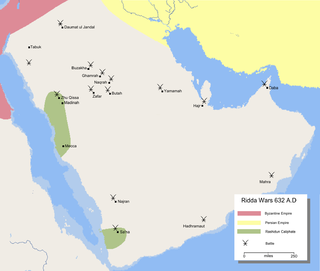
Abū Bakr ʿAbd Allāh ibn ʿAbī Quḥāfa was the senior companion and was, through his daughter Aisha, a father-in-law of the Islamic prophet Muhammad, as well as the first Caliph of the Rashidun Caliphate. He is known with the honorific title al-Siddiq by Sunni Muslims.
The 630s decade ran from January 1, 630, to December 31, 639.
Zayd ibn ʿAlī, also spelled Zaid, was the son of Ali ibn al-Husayn Zayn al-Abidin, and great-grandson of Ali ibn Abi Talib. He led an unsuccessful revolt against the Umayyad Caliphate, in which he died. The event gave rise to the Zaydiyya sect of Shia Islam, which holds him as the next Imam after his father Ali ibn al-Husayn Zayn al-Abidin. Zayd ibn Ali is also seen as a major religious figure by many Sunnis and was supported by the prominent Sunni jurist, Abu Hanifa, who issued a fatwa in support of Zayd against the Umayyads.
Zaydism is a branch of Shia Islam that emerged in the eighth century following Zayd ibn Ali‘s unsuccessful rebellion against the Umayyad Caliphate. In contrast to other Shia Muslims of Twelver Shi'ism and Isma'ilism, Zaydis, also sometimes incorrectly called Fivers, consider Zayd to be the Imam to whom obedience is obligatory, due to him being a patrilinial descendent of Fatima and making the Call (Dawah) to jihad, two necessary qualities for an Imam of Obedience for the Zaydis.
Banu Abd Shams refers to a clan within the Meccan tribe of Quraysh.

The Rashidun caliphs, often simply called the Rashidun, are the first four caliphs who led the Muslim community following the death of the Islamic prophet Muhammad: Abu Bakr, Umar, Uthman, and Ali.
Usāma ibn Zayd was an early Muslim and companion of the Islamic prophet Muhammad.
Ṭalḥa ibn ʿUbayd Allāh al-Taymī was a Companion of the Islamic prophet Muhammad. In Sunni Islam, he is mostly known for being among al-ʿashara al-mubashshara. He played an important role in the Battle of Uhud and the Battle of the Camel, in which he died. According to Sunnis, he was given the title "The Generous" by Muhammad.
Zayd ibn al-Khaṭṭāb was a companion of the Islamic prophet Muḥammad and a brother of Umar ibn al-Khattab, the second Islamic caliph.

Banū Taym was a clan of the Quraysh tribe of Mecca. The first caliph, Abu Bakr, hailed from the Banu Taym, as did another prominent companion of Muhammad, Talha ibn Ubaydallah.

The Ridda Wars were a series of military campaigns launched by the first caliph Abu Bakr against rebellious Arabian tribes. They began shortly after the death of the Islamic prophet Muhammad in 632 and concluded the next year, with all battles won by the Rashidun Caliphate. These wars secured the caliphate's control over Arabia and restored its nascent prestige.

Ali was the cousin and son-in-law of the Islamic prophet Muhammad, and a member of the Ahl al-Bayt. According to Shias, Ali was the first Imam who is believed to be the rightful successor to Muhammad, divinely appointed successors of Muhammad who are claimed by the Shias. Although Ali was regarded, during the lifetime of Muhammad, as his initial successor, it would be 25 years before he was recognized with the title of Caliph (successor). According to the status of Ali, it is believed he is infallible and sinless and is one of The Fourteen Infallibles of the household of Muhammed.

From 613 to 619 CE, the Islamic prophet Muhammad gathered in his hometown of Mecca a small following of those who embraced his message of Islam and thus became Muslims. The first person who professed Islam was his wife, Khadija bint Khuwaylid. The identity of the second male Muslim, after Muhammad himself, is nevertheless disputed largely along sectarian lines, as Shia and some Sunni sources identify him as the first Shia imam Ali ibn Abi Talib, a child at the time, who grew up in the household of his uncle, Muhammad. Other sources report that the first male convert was Abu Bakr, who later succeeded Muhammad as the first Sunni caliph, or Muhammad's foster son, Zayd ibn Haritha. While it is difficult to establish the chronological order of early conversions, the identities of early Muslims is known with some certainty.
Zayd bin Thabit was the personal scribe of the Islamic prophet Muhammad, serving as the chief recorder of the Quran text. He hailed from the ansar (helpers), but later joined the ranks of the Muslim army at age 19. After Muhammad's passing in 632, he was ordered to collect the Quran into a single volume from various written and oral sources. He was a noted expert on the Quran and spent much time reciting it.
Ubayy ibn Ka'b, also known as Abu Mundhir, was a companion of the Islamic prophet Muhammad and a person of high esteem in the early Muslim community.
Tulayha ibn Khuwaylid ibn Nawfal al-Asadi was a wealthy Arab clan chief and military commander during the time of Muhammad; he belonged to the Banu Asad ibn Khuzaymah tribe.
ʿAqīl ibn Abī Ṭālib, c. 580 – 670 or 683, was a cousin of the Islamic prophet Muhammad and an older brother of Ali and Ja'far ibn Abi Talib.
The Expedition of Usama bin Zayd was a military expedition of the early Muslim Caliphate led by Usama ibn Zayd that took place in June 632, in which Muslim forces raided Byzantine Syria. The expedition came three years after the Battle of Mu'tah.
Battle of Zhu Qissa, was a confrontation between the forces led by Tulayha and the forces of the Rashidun Caliphate.
The haras was a personal bodyguard unit of the caliphs during the Umayyads and the Abbasids. The haras was also instituted in the Emirate of Córdoba in present-day Spain.






